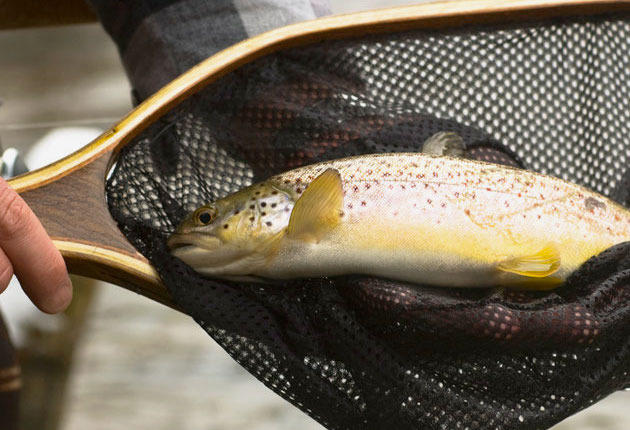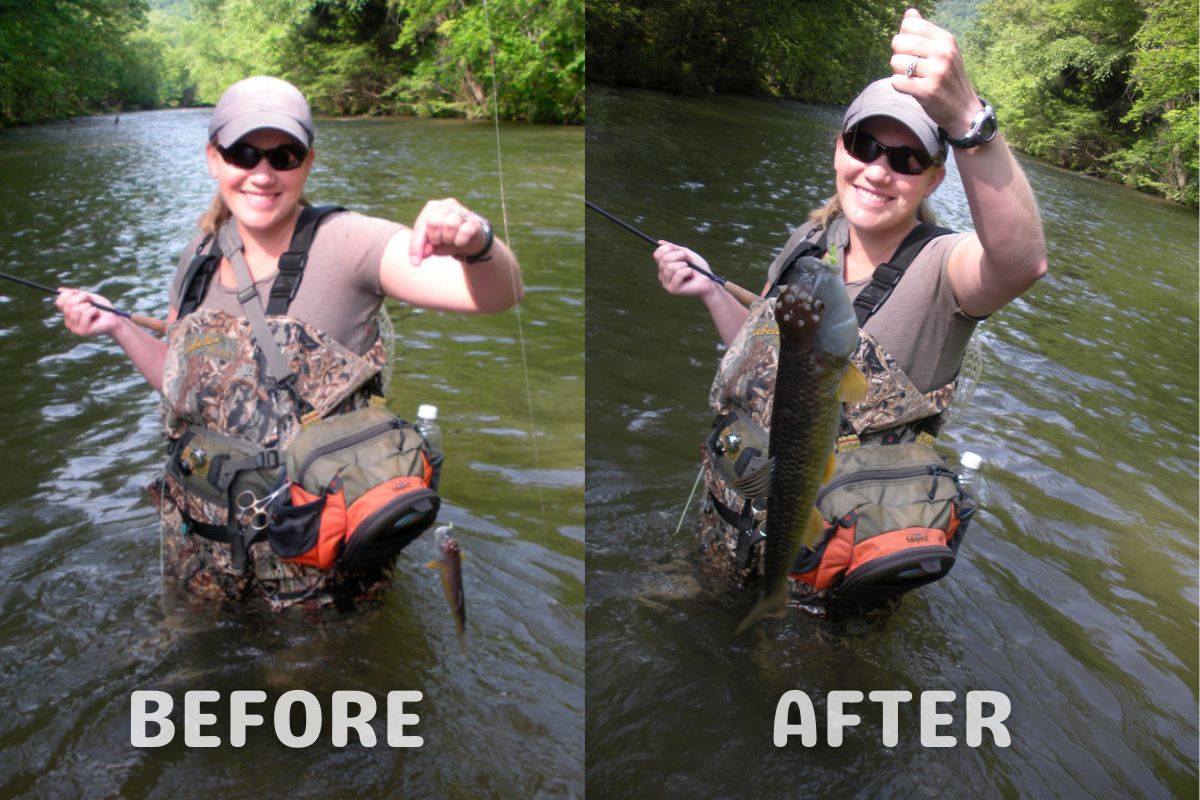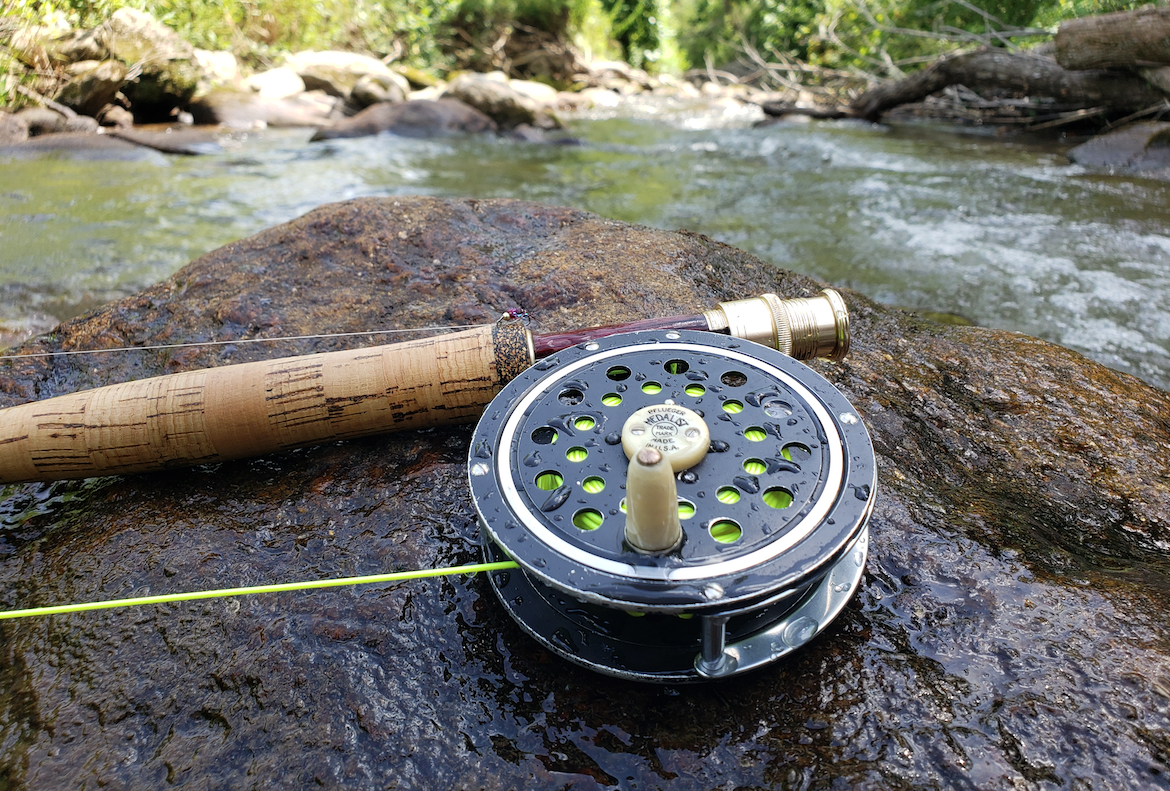The First Stage, and it probably seems fairly obvious to most folks, is that we want to catch a fish. That’s it. Just catch a fish. Which, if you’ve never caught one on a fly, can seem like a pretty daunting task. When I started messing around with the sport back in the ’80s, I picked up my first fly rod because hooking trout with my spinning gear had gotten a little too easy. If the fish were in the river and they were willing to bite, I was generally going to catch some. So fly fishing seemed like a natural progression. It was supposed to be more difficult, and I was looking for an interesting new challenge.
If I’d known just how challenging, though, I might never have made the switch. I fished two or three nights a week for a number of months before I caught my first trout, a handsome little brown who made the mistake of grabbing my dry fly (I don’t remember the pattern, but it was probably either a traditional Catskill tie or an Elk Hair Caddis) on the Housatonic River. Think about that for a minute. I went out and fished a couple dozen times without catching anything. That’s some pretty serious dues. As a matter of fact, I’ve never run across anyone else who’s admitted to residing in Stage One for nearly as long as I was there. And yet I eventually ended up working as a guide on the most acclaimed river in the country.
Go figure.
Stage Two is both the next level and the next logical step. Now that we’ve finally caught our first trout, or bass or whatever, we want to catch more. Lots more. Numbers become the game, because everyone knows that a bunch are better than a few, or one, or especially none. So we concentrate on quantity. After all, what could be more satisfying than landing a whole bushel full of fish?
I’ll tell you what — landing big ones. Which brings us to Stage Three.
If lots of fish was a vast improvement on where we started out, then big fish trump little ones. As I’ve mentioned in the past, we Americans have an affinity for large. Large everything—houses, cars, paychecks, fish, whatever. No matter what anyone who lives in a one-room apartment (or drives a dinky little car) tries to tell you, size does matter. Especially for Stage Three fly fishers.
But where do we go from there? We’ve caught our first fish, and then a bunch more, and finally some really, really nice ones. What’s next?
Well, for some folks, the answer is “Not much.” There are fly fishers out there who seem content with staying in Stage Three, and they take the pursuit of big fish to all sorts of crazy lengths. Steelhead, salmon, permit, stripers, tarpon, billfish—all appeal to the serious lunker-hunter, and they’re all perfectly reasonable ways to scratch our itch for oversized fish. Some anglers, though, find that size eventually becomes a secondary goal and they move on to Stage Four.
Stage Four is crazy. If we were skiing, we’d be hurtling down double black diamonds or better yet, some unnamed frozen cliff face in British Columbia. If we were bird hunting, we’d be making amazing crossing shots with our 28-gauge side-by-sides. But we’re talking fly fishing, so that means PHD fish and almost-impossible casts. In short, you consciously search out the most difficult-to-catch fish that you can find and then you stick him.
Or not.
Because failure is not only an option, it’s an imperative. If you’re not getting your butt kicked on a regular basis, you’re not pushing yourself hard enough.
Some years ago, my friend Steve Mate drove up to the Missouri River from the Henry’s Fork, hoping to take a guide’s holiday and hit some new water for a week. Yet three days later I saw Mate back on the Fork. When I asked him if the fishing on the Missouri had slowed down—we’d been hearing consistent reports of large browns and rainbows gorging on the surface for a month or more—he said, no, the fishing up there was still great. It was just that the trout were too damn easy. So he drove back down to the Henry’s Fork for some real angling.
Along those same lines, I once spent the better part of eight hours standing twenty-five feet behind an oversized, steadily-rising rainbow in Last Chance, Idaho. He kept rising, I kept casting. All afternoon and then well into the evening.
I finally caught him at dark, when he made the mistake of sucking in my size 26 midge emerger. But I couldn’t really claim victory. He’d refused my fly a thousand times; I hooked him once. That’s hardly even a draw. (As you might imagine, Stage Four can be tough on your ego.)
Finally, if the ultimate challenges of fly fishing eventually lose their shine, there’s always Stage Five. Believe it or not, when you reach Stage Five, you head in a completely new, non-goal-oriented direction. You just want to go fishing.
And since you’ve done it all a million times before, the catching, with its emphasis on, well . . . catching, loses most of its importance and all the other aspects—standing in the water and immersing yourself in the rhythm of your cast and the beauty of the place—grow exponentially more rewarding. If you happen to take the time for a little self-analysis, you’ll probably find that you’ve grown far more experiential at the same time you’ve stepped away from your concern with results.
That’s Zen-like, for those of you who dabble in Eastern philosophies.
You might even say that the Stage Five angler is the piscatorial equivalent of the wise man on the mountain. He (or she) has finally figured out that it’s never been about reaching a particular goal. Not really. It’s always been the journey. We just never realized it before.
So there you have it. The Five Stages of Fly Fishing, as you’re liable to hear them bandied about on the Beaverkill or the Henry’s Fork.
Which brings me to a few final thoughts on the subject: I suspect that there’s probably a great deal of truth contained in this particular way of looking at our sport. It resonates, at least for me. Yet if I had to quibble, I’d suggest that there might be a little too much rigidity built into this particular model. My personal experiences have taught me that anglers tend to move back and forth among the various stages without much regard for hard-and-fast parameters.
For example, one day we’re in Stage Five—“Yes, Grasshopper, the Great Truths of the Universe can be found in the Rings of the Rise.”—and the next, for reasons we probably don’t understand, we find ourselves back down in that comfortable old Stage Three/Four combo, hunting for the biggest, toughest fish we can find. Or perhaps even in Stage Two, gleefully catching everything that rises in our immediate vicinity, much like a kitten in a meadow full of butterflies.
I can honestly say that while I’ve spent a fair amount of time sitting on top of that metaphoric angling mountain, I seem to have an equal affinity for wandering around down in the lowlands of the earlier stages. And who knows? Maybe that’s exactly the way it’s supposed to be.
Cover image: thinkstock
 In My Life Was This Big, Lefty shares his tales of fishing expeditions with Fidel Castro and Ernest Hemingway, as well as solo battles with some of the scrappiest, most elusive fish in the world. Lefty also takes the reader through the development of his world-famous “Deceiver” fly style, and takes on the issue of conservation through catch-and-release. These timeless, often hilarious stories will put you in the boat with Lefty—and even teach you a thing or two about fly fishing along the way! Buy Now
In My Life Was This Big, Lefty shares his tales of fishing expeditions with Fidel Castro and Ernest Hemingway, as well as solo battles with some of the scrappiest, most elusive fish in the world. Lefty also takes the reader through the development of his world-famous “Deceiver” fly style, and takes on the issue of conservation through catch-and-release. These timeless, often hilarious stories will put you in the boat with Lefty—and even teach you a thing or two about fly fishing along the way! Buy Now





This is right. Yes, you can go back home in fishing.